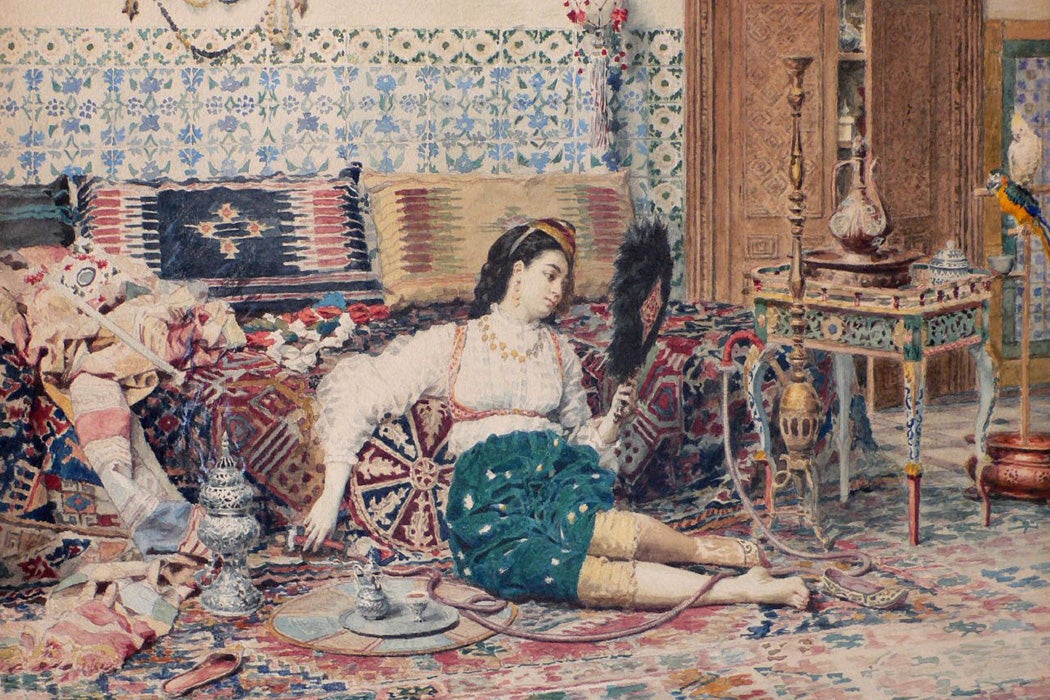In the nineteenth century, Western visions of “the Orient,” and particularly the harem, were populated by exotic, submissive women. But when American missionary women spent time in Turkey, they brought back a very different view, as architecture and design scholar Gülen Cevik explains.
Cevik writes that in the nineteenth century, homes in the Ottoman Empire were becoming increasingly segregated by gender. According to Cevik, “The informality of seating habits and the lack of clearly defined individual spaces were legacies of the Central Asian nomadic past of the Ottomans, where personal space was much more casually defined.” The typical seating arrangement was a divan—a low, continuous surface along the wall where people might sit in a variety of positions. As many Turks converted to Islam, however, separating homes into men’s and women’s quarters became an important way to prevent physical contact between men and women that the religion forbade.
For European and American travelers, the separation of quarters was a matter of intense interest. There was the selamlik, or “place of greeting,” for men. Cevik notes that the harem or haremlik (literally meaning “forbidden” or “prohibited”) was designated for women. Male tourists, banned from the harem, wrote imaginative stories of beautiful women kept imprisoned for men’s pleasure. Western painters reimagined flowing women’s garments, worn for modesty, as clingy and revealing.
Female Christian missionaries—both the wives of male missionaries and single women—had very different experiences of the harem. Many of them traveled to “heathen lands” with the idea of uplifting the status of women and freeing them from backwards sexism. Cevik writes that these American women “became participants in an intense dialogue with their ‘heathen sisters’ about their status as women and wives in the intimacy of their home.”
Missionary women often gave talks to raise funds for further missionary activity, as well as letters published in religious journals. Through these formats, the women’s observations about Turkish life and the harem made their way into U.S. life. One Methodist Missionary Society publication describes a returning missionary inviting a church’s children to “a Turkish tea party,” asking them to remove their shoes and sit on cushions from the church pews.
Weekly Digest
In the years when there was the most American missionary activity in Turkey, style magazines and etiquette books increasingly featured Turkish clothing and furniture. Turkish design elements—seating, fabrics, and plush cushions—made their way into many middle-class U.S. homes. Americans often created “Turkish corners” with these furnishings. Cevik notes how dramatically this interpretation of a harem contrasts with much Western writing about that setting.
For U.S. men, Cevik writes, Turkish elements might feature in “smoking rooms”—the man caves of their day—offering “fantasies about far-off exotic places where men could still enact the rituals and special privileges of their gender.” But for women, the meaning of Turkish design was completely different. Avant-garde groups like the Aesthetic Dress Movement and the Rational Dress Society recommended Turkish clothing as more comfortable than American styles. Amelia Bloomer, publisher of the early feminist journal The Lily, described the Turkish pantaloons as a better alternative to Western dress. Thus, at the same time as American missionaries expressed sympathy for oppressed “oriental women,” they also helped make Turkish dress a symbol of women’s liberation.







